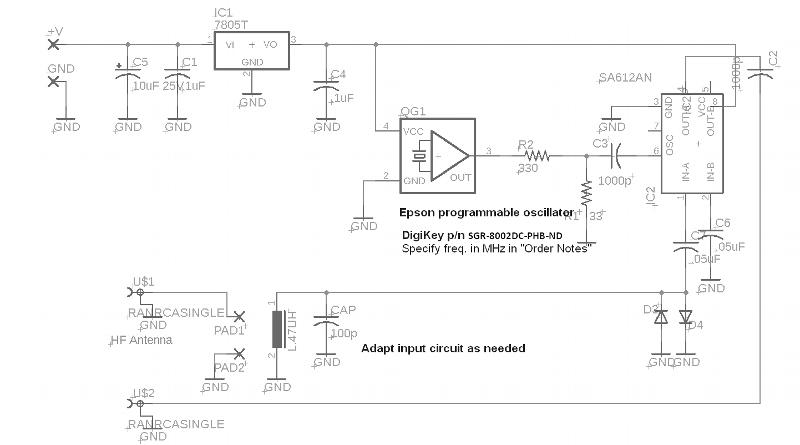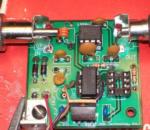
Posted By: Robert Nickels (ranickels) Posted: 03/17/2022 Technical 03/17/2022 |
Universal Frequency ConverterModify as needed |
|
I found myself wanting to convert various frequencies to other frequencies and wanted a cheap and easy solution, so I designed a simple "universal converter" using the NE-602 and a programmable oscillator from Epson. I'd used the same combination in hundreds of "RANVerter" SDR Upconverter projects since my Dec. 2013 QST article and knew that while there were limitations, this was a good combination for a simple yet functional solution. The NE-602 is well understood to have a limited dynamic range, but on the other hand provides useful conversion gain that more than offsets mixing losses and on the lower HF bands at least, makes an RF amplifier unnecessary. The Epson oscillator outputs a square-wavish TTL level signal which purists complain is not ideal for use as a local oscillator but which provides good results regardless. The output is attenuated to meet the LO input requirement of the 602, otherwise it's straight off the datasheet and many 602 app notes that are easily found. I included a 5 volt regulator so the converter can be powered from existing 12VDC power sources or with a voltage double running from a 6.3VAC filament line. My input filter is totally inadequate - yet works well! Just a fixed inductor and resonating capacitor for the band of interest and a couple of turns to link couple to the low-impedance antenna. Thanks to the conversion gain of the NE-602 the resulting sensitivity when used ahead of a Command Set or boat radio is sufficient to hear every signal that is there to be heard. Obviously better front-end selectivity would be a plus, and a double-tuned preselector should be a good solution or a low-pass filter could be used to knock out an image. Here's an example of using this converter to shift the 455 kHz IF froma little shortwave receiver to 3395 kHz where it is displayed on a Heathkit SB-620 panadator VIDEO Another video example of the universal converter used to convert the 75 meter ham band down to the range of I2PHD's Arm Radio: As noted on the schematic, the Epson oscillator can be ordered from DigiKey by specifying the desired LO frequency IN MHZ in the "Order Notes" box on their order entry form. It is a value-added part so will show as "backordered" but typically it takes a day or less for them to program your frequency into the chip.
|
|
Related Images
Click on the image title or on the image itself to open the full-sized image in a separate window.Latest Articles
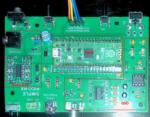
Technical
Posted: 01/29/2025
Comments: 0 |
Pico Rx performance - Excellent performance on 630m WSPR
The Simple Pico Rx is my minimalist implementation of Jonathan Dawson's "Pico Rx" at 101things: https://github.com/dawsonjon/PicoRX In this basic form the receiver consists of a Quadrature Sampling Detector (QSD aka Tayloe) and the Pico2 MCU which handles all DSP functions. There are NO front-end filters, the only bandwidth limitation comes from the tracking filter... READ MORE |
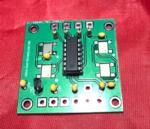
Crystal Replacement
Posted: 08/226/2024
Comments: 0 |
Making SMT "no lead" parts easier to use
SMT is the future - but how can we actually use parts without leads? ... READ MORE |
|
Crystal Replacement
Posted: 02/38/2024
Comments: 0 |
How good can a crummy receiver be?
Hundreds of different simple SDR receivers have been designed around Dan Tayloe's Quadrature Sampling Detector or QSD. Mine add nothing to the state of the art, and in fact subtract things, as I like minimalist solutions and the QSD is right in that sweet spot. Following the evolution of Tayloe's design I delete the resistors in series with the sample lines for inst... READ MORE |
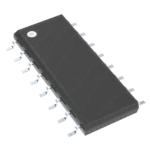
Technical
Posted: 02/37/2024
Comments: 0 |
What's in a number (3253)?
The FST3253 dual four-to-one mux/demux IC has long been used as a "Tayloe Detector" or QSD (and QSE) in low-cost SDRs. They provide incredible performance for such a simple circuit, converting RF to baseband IQ with low loss and the ultimate in simplicity. Unfortunately the original FST3253 part has become obsolete and while substitutes are available, this is where the... READ MORE |
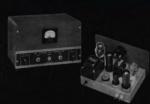
Vintage Ham Radio
Posted: 02/32/2024
Comments: 0 |
The Stancor 10P Transmitter
There weren't really many commercial transmitters in the 1930s as most hams built their own. But many of the ones that were offered came from the transformer companies who had two chances to profit. First, from those who would buy the kit, and two, from those would would see it in the (free) booklets the companies provided to their distributors who would then sell the iron to ham... READ MORE |
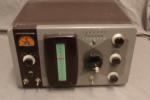
Vintage Ham Radio
Posted: 12/355/2023
Comments: 0 |
The Care and Feeding of the EF Johnson Courier amplifier
The EF Johnson "Courier" is a grid-driven amplifier using two 811A tubes. Switching is provided for operating in either class C for CW or as a class B linear amplifier for AM or SSB. Rated power is 500 watts input for CW, 500 watts PEP input for SSB, and 200 watts input for double-sideband AM with carrier. Since all amateur power levels were meas... READ MORE |

Historic
Posted: 11/329/2023
Comments: 0 |
TV Duplexer
Some things are interesting, even if totally useless nowadays. Such is the case with the Philco 426-3034 Crossover Kit for UHF TV. What the heck is that? Well, back in the late 50s, UHF television stations operating on channels 14-83 started to appear in many areas of the US where viewers had a VHF-only TV antenna, and in many cases an externa UHF converter was... READ MORE |
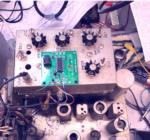
Crystal Replacement
Posted: 11/327/2023
Comments: 0 |
Replacing failed crystals
For decades, quartz crystals were used everywhere a stable frequency source was needed, even in some applications that depended on overtone (harmonic) behavior into the VHF range. These crystals were less stable and more dependent on circuit parameters that fundamental types and thus more problematic. Such was the case with the 94 MHz crystal in the 2 meter converter ... READ MORE |
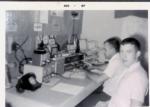
Historic
Posted: 11/315/2023
Comments: 0 |
My Own Ham Radio Story by W9RAN
Everyone has a story of how they got involved in ham radio - this is mine. It started much earlier, including receiving a Knight Kit Span Master shortwave radio for Christmas in about 1963, at age 12. I'll never forget the night my dad and I finished building it and I wanted to try it out. It came with a 50 ft. antenna which was still coiled up - but ... READ MORE |
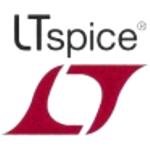
Technical
Posted: 09/267/2023
Comments: 0 |
Hot to simulate vacuum tubes in LTSpice
LTSice is a powerful simulation tool that is provided free by Linear Technology Corp. It comes with a complete library of passive and common analog solid-state components but if you want to use it to simulate vacuum tubes, it doesen't work as-is. Even though triode and pentode symbols can be found in the "Misc" folder, they are just schematic symbols and... READ MORE |
